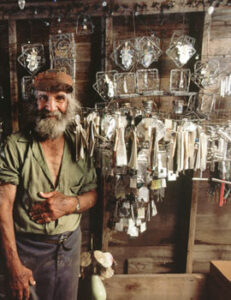 BLAGDON, EMERY
BLAGDON, EMERY
(1907–1986)
produced approximately six hundred intricate wire and wood sculptures—some freestanding, others made to hang on a wall either chandelier-like or flatter—and eightysmall paintings on wood. He never thought of himself as an artist, but rather felt that his works were part of a giant healing machine meant to cure arthritis, rheumatism,and other ailments, and that each piece had different properties. His works were created and installed in a shed next to his house, and these sculptures and paintingswere the focus of his life for decades.Local residents in his community agreed with Blagdon’s claims that his assembled objects had special properties released through electromagnetic fields, and theyvisited his work shed for its curative properties. Blagdon believed so strongly in the curative properties of his works that he stacked his small paintings, designed withmandala-like circles, stripes, and curved and intersecting linear forms, some with echoing bands of earth colors, one on top of the other, placing the painted sides down,to create more effective magnetic fields for healing.Born in central Nebraska, Blagdon received an elementary education, worked at farming, and then left Nebraska to explore the world. An inheritance in 1954 of 160 acres of farmland and a house brought Blagdon back to Nebraska. He took up farming again but did not like the work, so he decided to sell part of his property.The money allowed him to begin work on his “machines.” Bent and twisted copper or steel wire were basic elements in his work. He set the wire in a myriad of rhythmically patterned shapes, embellished with beads, ribbon, aluminum strips, plastic, and tinfoil. Blagdon’s wire constructions appeared magical as they reflected thelight coming through holes in his work shed’s walls. This dense assemblage of clustered works also twinkled and glowed from the illumination of tiny Christmas lightsthat he installed above, and from the painted light bulbs that he set out in coffee cans on the ground as well as on the planked path to his shed. Although he had no previous artistic experience, Blagdon worked consistently on his art for thirty years.Dan Dryden, a local pharmacist, discovered Blagdon’s artistic talent on a visit to his shed in 1975. Following the artist’s death, in 1986, Dryden and some friends purchased Blagdon’s life’s work at auction, and became its curators. The artist’s work has been shown in Europe and the United States.
See also
Environments, Folk; Sculpture, Folk
.
BIBLIOGRAPHY
Gergen, Kenneth J. “Emery Blagdon.” in
Self-Taught Artists of the Twentieth Century: An American Anthology.
edited by Elsa Longhauser, et al. New York: Museumof American Folk Art, 1998.
